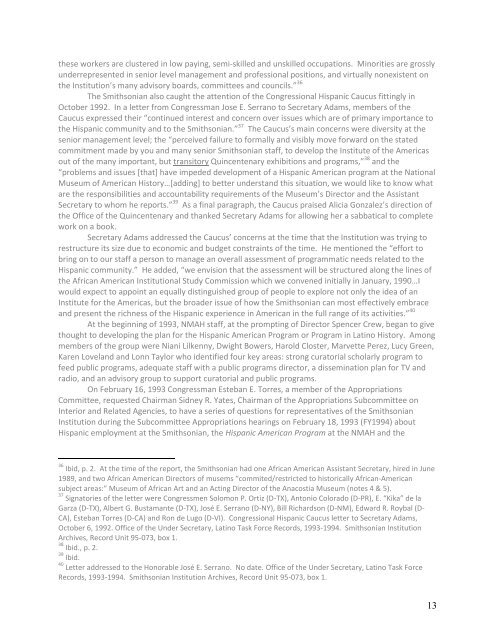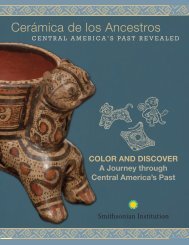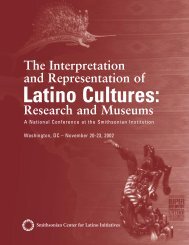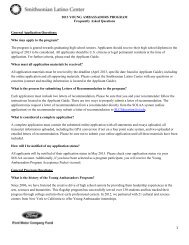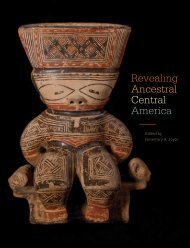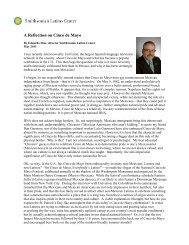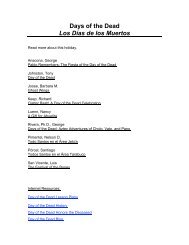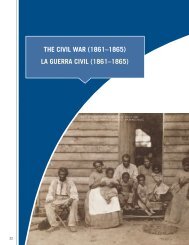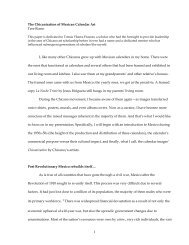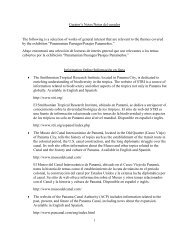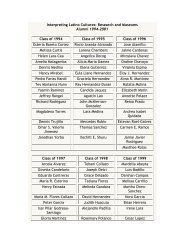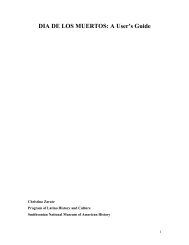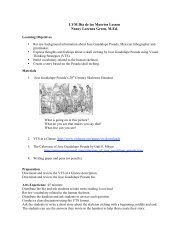smithsonian latino art collections - Smithsonian Latino Center
smithsonian latino art collections - Smithsonian Latino Center
smithsonian latino art collections - Smithsonian Latino Center
You also want an ePaper? Increase the reach of your titles
YUMPU automatically turns print PDFs into web optimized ePapers that Google loves.
these workers are clustered in low paying, semi-skilled and unskilled occupations. Minorities are grossly<br />
underrepresented in senior level management and professional positions, and virtually nonexistent on<br />
the Institution’s many advisory boards, committees and councils.” 36<br />
The <strong>Smithsonian</strong> also caught the attention of the Congressional Hispanic Caucus fittingly in<br />
October 1992. In a letter from Congressman Jose E. Serrano to Secretary Adams, members of the<br />
Caucus expressed their “continued interest and concern over issues which are of primary importance to<br />
the Hispanic community and to the <strong>Smithsonian</strong>.” 37 The Caucus’s main concerns were diversity at the<br />
senior management level; the “perceived failure to formally and visibly move forward on the stated<br />
commitment made by you and many senior <strong>Smithsonian</strong> staff, to develop the Institute of the Americas<br />
out of the many important, but transitory Quincentenary exhibitions and programs,” 38 and the<br />
“problems and issues [that] have impeded development of a Hispanic American program at the National<br />
Museum of American History…[adding] to better understand this situation, we would like to know what<br />
are the responsibilities and accountability requirements of the Museum’s Director and the Assistant<br />
Secretary to whom he reports.” 39 As a final paragraph, the Caucus praised Alicia Gonzalez’s direction of<br />
the Office of the Quincentenary and thanked Secretary Adams for allowing her a sabbatical to complete<br />
work on a book.<br />
Secretary Adams addressed the Caucus’ concerns at the time that the Institution was trying to<br />
restructure its size due to economic and budget constraints of the time. He mentioned the “effort to<br />
bring on to our staff a person to manage an overall assessment of programmatic needs related to the<br />
Hispanic community.” He added, “we envision that the assessment will be structured along the lines of<br />
the African American Institutional Study Commission which we convened initially in January, 1990…I<br />
would expect to appoint an equally distinguished group of people to explore not only the idea of an<br />
Institute for the Americas, but the broader issue of how the <strong>Smithsonian</strong> can most effectively embrace<br />
and present the richness of the Hispanic experience in American in the full range of its activities.” 40<br />
At the beginning of 1993, NMAH staff, at the prompting of Director Spencer Crew, began to give<br />
thought to developing the plan for the Hispanic American Program or Program in <strong>Latino</strong> History. Among<br />
members of the group were Niani Lilkenny, Dwight Bowers, Harold Closter, Marvette Perez, Lucy Green,<br />
Karen Loveland and Lonn Taylor who identified four key areas: strong curatorial scholarly program to<br />
feed public programs, adequate staff with a public programs director, a dissemination plan for TV and<br />
radio, and an advisory group to support curatorial and public programs.<br />
On February 16, 1993 Congressman Esteban E. Torres, a member of the Appropriations<br />
Committee, requested Chairman Sidney R. Yates, Chairman of the Appropriations Subcommittee on<br />
Interior and Related Agencies, to have a series of questions for representatives of the <strong>Smithsonian</strong><br />
Institution during the Subcommittee Appropriations hearings on February 18, 1993 (FY1994) about<br />
Hispanic employment at the <strong>Smithsonian</strong>, the Hispanic American Program at the NMAH and the<br />
36 Ibid, p. 2. At the time of the report, the <strong>Smithsonian</strong> had one African American Assistant Secretary, hired in June<br />
1989, and two African American Directors of musems “commited/restricted to historically African-American<br />
subject areas:” Museum of African Art and an Acting Director of the Anacostia Museum (notes 4 & 5).<br />
37 Signatories of the letter were Congressmen Solomon P. Ortiz (D-TX), Antonio Colorado (D-PR), E. “Kika” de la<br />
Garza (D-TX), Albert G. Bustamante (D-TX), José E. Serrano (D-NY), Bill Richardson (D-NM), Edward R. Roybal (D-<br />
CA), Esteban Torres (D-CA) and Ron de Lugo (D-VI). Congressional Hispanic Caucus letter to Secretary Adams,<br />
October 6, 1992. Office of the Under Secretary, <strong>Latino</strong> Task Force Records, 1993-1994. <strong>Smithsonian</strong> Institution<br />
Archives, Record Unit 95-073, box 1.<br />
38 Ibid., p. 2.<br />
39 Ibid.<br />
40 Letter addressed to the Honorable José E. Serrano. No date. Office of the Under Secretary, <strong>Latino</strong> Task Force<br />
Records, 1993-1994. <strong>Smithsonian</strong> Institution Archives, Record Unit 95-073, box 1.<br />
13


